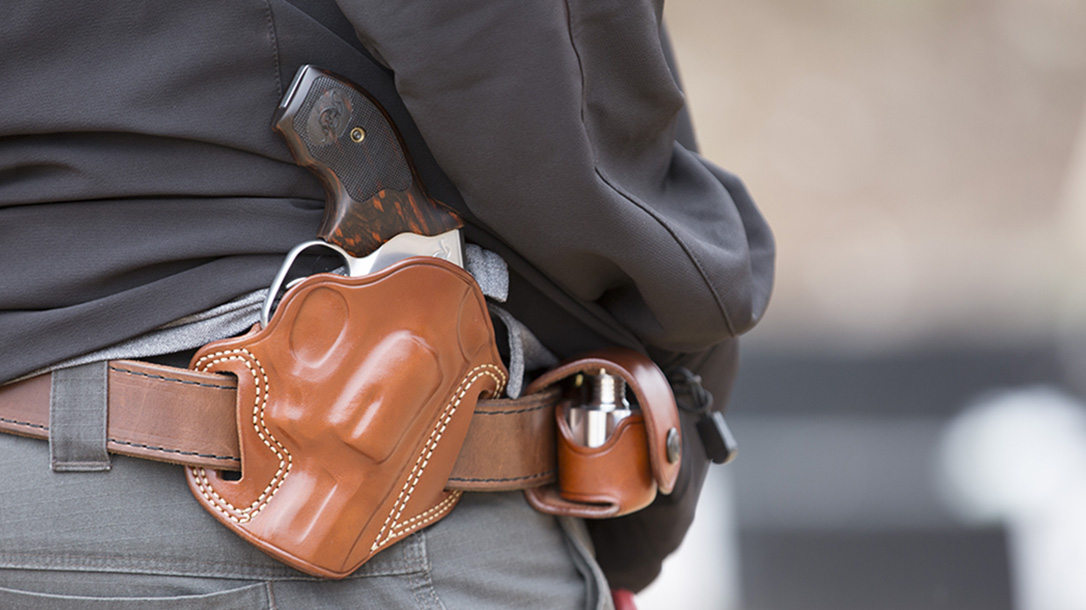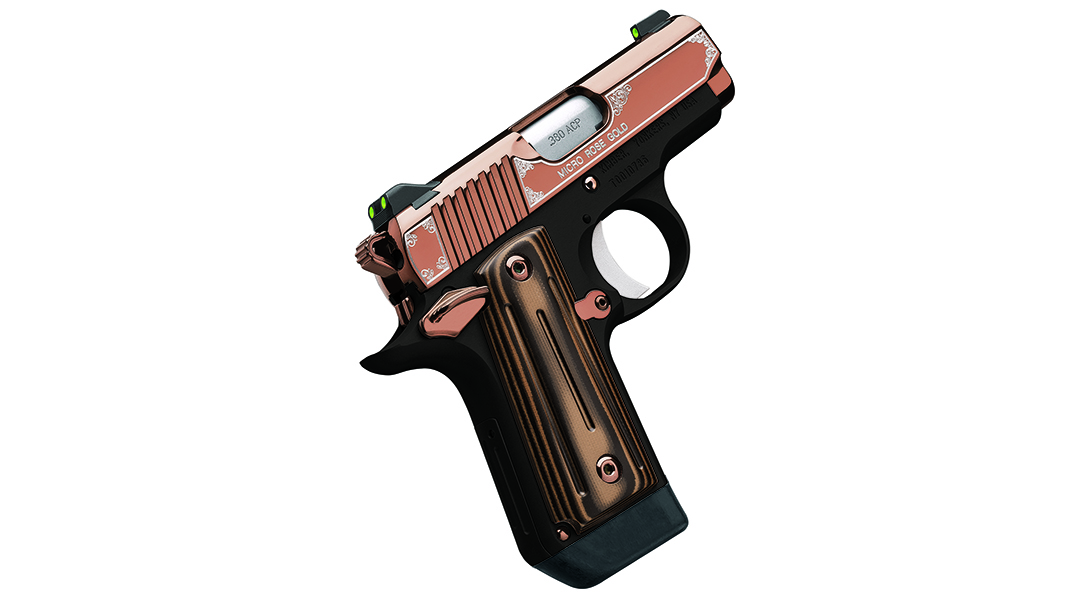What makes the perfect handgun for new female shooters? That’s a loaded question. Handgun selection depends on what you plan on doing with it. Personal protection is likely to be at the top of that list, but marksmanship, competition, skill building and a number of other reasons make the list as well.
Whatever the reason a woman has for learning how to shoot, there’s really only one reason that will keep her coming back: It has to be enjoyable. In order for the shooting to be fun, the handgun you’re using has to be comfortable. There’s no fun in getting blisters or raw spots because of rough edges. Equally uncomfortable are sore muscles from a gun that’s too heavy or too big. Even worse are the body aches from training with a weapon that has too much recoil for you to effectively handle. There’s definitely a balance that each woman has to find when it comes to training with a firearm. An appropriate balance of size and caliber is needed to make the experience enjoyable enough to want to do it again and again and again.
Advertisement — Continue Reading Below
Size & Caliber
When it comes to size, you need a handgun that fits your hands and body. There are two things to consider regarding size. First, how does it fit your hands? Is it comfortable? Sometimes the grip is just too big and there’s no way to modify it. Comfort is tough to quantify, and it’s the number one reason you need to “try before you buy.” The second thing to consider is whether or not you’re going to carry your handgun concealed. A small body will not be able to effectively conceal a full-sized handgun, so that will need to be considered.
When it comes to caliber, it’s important to choose one that you can shoot accurately as well as consistently. Anyone can shoot a hand-cannon one time, but to do so often enough to become proficient is unlikely. The firearm is a great equalizer. It does the same thing no matter who pulls the trigger, so it’s important to find the weapon that you can handle effectively. This most likely means a caliber between .380 and .45 ACP. You may need to use your shooting skills for defensive purposes; this is the best range for effectiveness.
The .380 ACP is considered by most to be the power floor, meaning it’s the smallest caliber that has sufficient defensive capabilities. The .45 ACP is at the top of my power range because I find it’s still comfortable to shoot, which means I can train with it. Beyond a .45 ACP, however, and it may get unwieldy and uncomfortable to shoot. One thing I’ve learned is that if it’s not comfortable to shoot, I’m not going to train with it.
Advertisement — Continue Reading Below
The size of the gun and the caliber you choose will determine the amount of recoil you’re going to experience. Too much recoil isn’t necessarily due to the gun being too big for you—it’s just that the mass of the gun matters. More times than not, it’s that the round is too powerful for the reduced frame size. People often think they want a super-small gun until they actually shoot it.
Moving On
Now that we’ve covered the balance of size and caliber, let’s move onto the guns. For this article, we’ll avoid getting bogged down in minutiae and focus our attention on three main groups: striker-fired pistols, revolvers and 1911s. To be fair, you need to try several models out of each category to really know which will fit you best. In the world of handguns “try before you buy” is the mantra you need to follow, or you may find yourself suffering from more than buyer’s remorse. Luckily, it’s quite common now to rent firearms for the sole purpose of trying them out before you make a purchase.
Striker-Fired
So, let’s begin by looking at guns in the striker-fired group. Striker-fired pistols have no external hammer and typically no dedicated mechanical safety lever on the side of the gun. All of the safety mechanisms are built inside the gun and are activated and deactivated by the manipulation of the trigger. The most obvious benefit to not having an external safety is that it’s much quicker to get it into the fight. The options available in the striker-fired realm are enormous, but from my personal experience there are three that are worth mentioning: the Glock 19, Glock 43 and Smith & Wesson M&P CORE.
Advertisement — Continue Reading Below
Glock’s Solution
Glocks make a great choice for women, first-time shooters, men—well, just about anyone. The Glock 19 is a compact 9mm pistol that comes with Glock’s innovative Modular Backstrap System, which allows you to fine-tune the grip size to fit you just right. I like the Glock 19 because it’s slender, a tad bit shorter and easy to carry. This handgun made a world of difference for me when I participated in a defensive handgun course.
I started out with a full-sized Glock 17 and struggled with accuracy because I was constantly fidgeting, trying to get a good grip. The Glock 19 was given to me to try, and just like that, the problem was solved. No, I wasn’t immediately winning class competitions, but my enjoyment level skyrocketed. The Glock 19 just fit me better and was so much more comfortable. It was a perfect fit when I drew it from the holster; I could focus on the skills being practiced. Making the change to the Glock 19 saved the day for me and helped me fully enjoy the rest of the course.
The Glock 43 is another 9mm pistol that I like. Because of its smaller size, it makes for a perfect everyday-carry handgun. The first thing I noticed in handling this gun was its size. Because it uses a single-stack magazine, the gun is very thin, which meant my hands could get a good grip. The second thing I noticed was the trigger. The Glock 43 comes with the standard Glock trigger, which means there was no learning curve—it shot just like the Glock 19. This made for an easy transition between the two pistols and gives me confidence that I can perform well with either one.
Advertisement — Continue Reading Below
Solid Smith & Wesson
The last handgun I want to mention in the striker-fired group is the Smith & Wesson M&P CORE. This is an extremely reliable pistol that is also extremely comfortable to shoot. Due to its low bore axis, it feels natural to draw the weapon and take aim. The benefit to this is increased accuracy. Its slender frame and adjustable grip make it comfortable to shoot, and it looks good, too. The S&W I had the pleasure of shooting had a Trijicon RMR reflex sight mounted on top. This was a great reminder that you do not need to limit yourself to guns with traditional sights.
The benefits of shooting with an optic is that it’s very easy to get on target, improving your speed and accuracy dramatically. These optics have been used in competition circles for decades and are now commonly found on defensive handguns. This pistol is definitely worth checking out as you peruse the many options available.
Wheelguns
A revolver, or wheelgun, is most recognizable by the cylinder that rotates as you pull the trigger, taking you back to the days of the Old West. Even though they have been romanticized by movies and cowboy reenactments, they remain a solid choice for today.
Advertisement — Continue Reading Below
In the revolver world, one of the most enjoyable I’ve shot is the Kimber K6s. The K6s is the lightest .357 Magnum revolver on the market, making it a popular choice for women. What I found to be so nice about the K6s is that Kimber took the time to round all the edges, making it sleek and smooth so it won’t snag on anything.
Besides the smooth finish, the K6s is an easy gun to shoot because it comes with traditional sights. That’s not common with most snub-nose revolvers. Another reason I enjoyed shooting the K6s so much was its heft. It feels good and solid in your hands, allowing you to shoot without as much kick as you’d think for such a small handgun.
Advertisement — Continue Reading Below
Trusty 1911s
The last group we’ll consider are 1911s. These are easily recognized because they have external thumb and grip safeties. Both the external safety lever and the grip safety must be disengaged for the weapon to fire. With practice, this becomes second nature.
Kimber has produced a real beauty in this category; the compact Kimber Rose Gold Ultra II will definitely make you want to train. The Rose Gold Ultra II is a strikingly beautiful gun with fine etching, smooth edges and a unique rose gold finish that speaks to the era of The Great Gatsby. Besides its good looks, the pistol has the standard 1911 trigger, which is so well known for being smooth and easy to shoot.
I’ve shot full-sized as well as compact 1911s and enjoyed shooting them both mainly because I found them easy to be accurate with. However, I have to be realistic and admit the chances of me carrying a full-sized 1911 are slim, which is why I turned to Kimber’s Rose Gold Ultra II. It’s much smaller, but with its heft, I was able to manage the recoil and achieve an acceptable level of accuracy. And it’s adorable!
Advertisement — Continue Reading Below
New Female Shooters
It’s exciting to introduce anyone to the world of shooting, but if you want women to continue shooting, it must be an enjoyable experience. Which firearm they use will determine how much they enjoy it. It absolutely needs to be comfortable to shoot. There are as many different options of handguns as there are types of women, so take the time to try before you buy to figure out which one is right for you. Maybe you’ll find several. After that, get to the range and become proficient and comfortable with your new friend. It’ll be the beginning of a beautiful friendship.
This article was originally published in the winter/spring 2018 issue of “Personal Defense World.” To order a copy and subscribe, visit outdoorgroupstore.com.
































